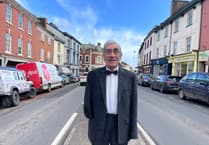Fernley Heath, of Castle Way, Newton Abbot, writes:
I suppose there are few Newtonians to whom August 20 holds any particular significance. The events of the day in 1940 remain as clear in my head now as on the day. It was the day Newton Railway Station was bombed 70 years ago.
A lad of nine years at the time, I lived with my parents at 42 Wolborough Street (now the site of Asda car park). At about 6.45pm we were just leaving our house when aircraft noise turned our attention towards St Leonard's tower.
I actually saw bombs leave an aircraft flying low, between the Globe Hotel and the tower. My mother and I took shelter in a hallway of an adjacent shop laying on the floor of the hall with the owner, Mrs Clyburn, and her two daughters. My father, being a first world war veteran preferred to watch events from the street.
Gradually afterwards people began to emerge from their improvised shelters and rumour spread that the station had been the target.
The following day, curiosity drew many people to the site, my family included, and I well remember seeing the sections of railway line blown into Courtenay Park one in particular demolishing a park bench to the west of the bowling green. The station itself was off limits but the destruction of Station Cottages (roughly the site of the Northern Station Road bridge) was complete.
A bomb took the corner off a house at the southern corner of Forde Park and another took the bay front off a house at the top of the park. The station itself was clearly seriously damaged. One could see the damaged platforms and particularly the damage to the roof which had lost most of the glass with which, up to that event, it was constructed. Generally rolling stock had still yet to be recovered. The observant can still see damage to the roof girders above the platform.
I learned that day that a school friend had been shot in the wrist. He was somewhat unlucky but he could well have joined one of the 14 people killed by the raid instead of being one of the 16 seriously injured.
An account of the raid from the railway enthusiast's point of view was published in a well-illustrated booklet form in 1991 by Ark Publications.
My future father-in-law, Herbert Norris, had a photographic studio at 18 Queen Street and he was commissioned at very short notice to photograph the carnage within the carriages and on the platform before clearing up had been started. His tales were somewhat harrowing but he never allowed me to see the results and it was difficult to get him to talk about it.
This was the event that brought home to Newtonians the fact that we were at war. Up to that time static water tanks were constructed at various places, air raid shelters were built, an overground steel water pipe laid along the gutter in Courtenay Street and civic buildings were sandbagged but the true horror of war was a long way off until this point.
l See our feature on the bombing of the town on pages 20 and 21THIS AND OTHER LETTERS IN OUR ONLINE EDITION



